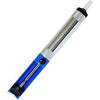500EXT Assembly Guide
Damaged or Missing Parts All kits and parts are checked before being shipped to you. If something arrives damaged or if your kit is missing a part, please open a support ticket to inquire about a replacement. Missing parts will be replaced at our expense. Damaged parts should be returned for verification. If the part shows signs of use beyond what was necessary to determine that it was damaged, DIY Recording Equipment, LLC reserves the right not to replace the part.
Thank you for purchasing a 500EXT 500 Series Extender Kit!
If this is your first DIY project ever, we recommend reading our Getting Started Guide.
Required Tools
You'll need the tools below to complete this build.

Soldering Iron
We recommend an adjustable-temperature station, such as the $40 Weller WLC100.

Solder
You can use 60/40 "leaded" solder or lead-free. We recommend 60/40 because it flows better and is easier for beginners to use.

Wire Cutters
You'll need a pair of good "snips" for cutting of the excess leads after soldering.
Optional Tools
These tools aren't strictly necessary but can make your build a bit easier.

Multi-Meter
If you find the color bands on resistors a bit hard to read, you can use a meter to sort them with absolute confidence.

Desoldering Pump
If you accidentally solder something in the wrong place, a desoldering pump can save the day.
Assembly

Break Apart the PCBs
Snap apart the two circuit boards (PCB) against a hard surface.

Solder the Card-Edge Connector
Place the card-edge connector in the J1 position. Double check that the connector is on the correct side of the board: the blue, plastic body of the connector should be on the same side as the DIYRE logo. Once you've confirmed the position, solder the connector and trim the excess leads down to the solder joint.

Solder the Ribbon Cable to CON1
Place one end of the ribbon cable in the CON1 position. The ribbon should sit on the opposite side of the board from the card-edge connector. The ribbon cable should face down toward the card-edge connector. Confirm the orientation of the connector, then solder and trim.

Solder the Ribbon Cable to CON2
Place the remaining end of the cable in the CON2 position. Make sure that the blue, plastic connector is on the same side of the PCB that says "CON2" and "v1.0 2018." Orient the PCB so that the ribbon cable does not cover the card-edge pads, then solder and trim.

Complete!
Your 500EXT is now complete. To use it, plug your 500-series module into the connector as shown, and plug the PCB with the card-edge fingers into a slot of your 500-series rack. Orient the card-edge PCB in your rack so the "v1.0 2018" text is on the lower end of the connector.
You can use the pads above the connector to make sure power is getting from your rack to the 500EXT. Set your multi-meter to read DC volts, place the black probe in the "Gnd" pad, and place the red probe on the +16v, -16v, or +48v pads to test their actual voltages.
Final Checks
Before you wrap up, check the following things:
-
Soldering: Is every solder joint shiny and clean? If one is cloudy or misshapen, try reheating it for 8 seconds and adding a tiny bit more solder.
-
Trimming: Are all of the excess leads trimmed down as close to the joint as possible?
All good? Congrats on finishing your build! Have a question or problem? Drop us a line.
Help Us Improve
1
2
3
4
5
6
7
8
9
10


